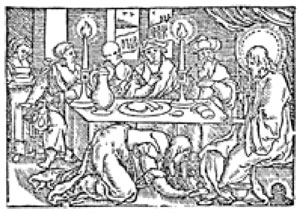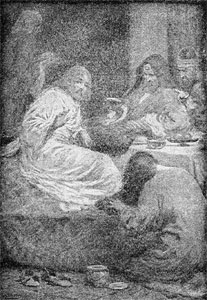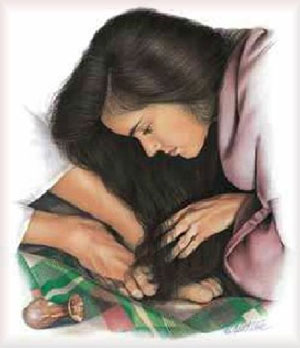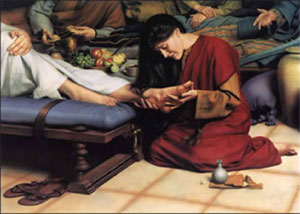
Christmas
Easter
Pentcoest
All Saints
Christ The King
Confirmation
Palm/Passion
Reformation
Stewardship
Books of the Bible
Lenten Series
Christmas Dramas
Videos
Series A - Matthew
Series B - Mark
Series C - Luke
Series D - Other
To contact
Edward F. Markquart
info@sfs.com
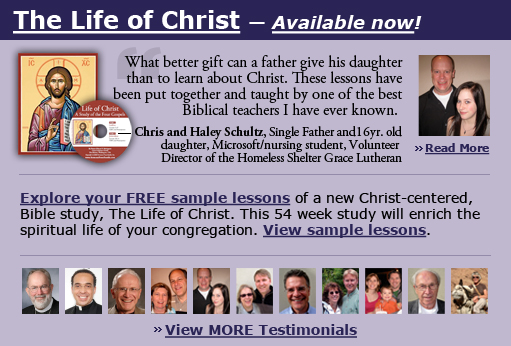
Series C Lent 5C: John 12:1-8 The following Bible study is from a larger course entitled, THE LIFE OF CHRIST: A Study in the Four Gospels. This 54 week course for the laity will be available for congregations in 2006. Basic text for the course: SYNOPSIS OF THE FOUR GOSPELS, Kurt Aland, English Edition, pp. 231-232. #267. The Anointing At Bethany John 12:1-8
Notice that we seem to have three versions of the same story: Matthew/Mark, John and Luke. Matthew and Mark’s versions are very similar and are parallel in almost every way. John has a version of the story that is similar to Matthew and Mark’s. That is, both stories occur in Bethany. Both stories say that the value of the ointment is three hundred denarii or three hundred day’s wages or the sum total of an annual wage. Both stories say that the woman’s pouring of the ointment was preparing Jesus for burial. But the details in John’s story are so different than Matthew and Mark. In John’s version of the story, the characters of Mary, Martha and Lazarus are named; Mary is the person who anoints Jesus’ feet (not head as in the Gospel of Mark) with oil; Judas, the keeper of the treasury bag and a thief, is worried about money that could have gone to the poor. The details of the story in John are different but the basic story is the same as in Matthew and Mark: a woman anointed Jesus’ body with oil and thereby prepared him for burial. The oil was enormously costly, 300 days wages or an annual salary. The disciple/s objected, and said the money should be given to the poor. Luke places this story in an anti-Pharisee section. Luke has such a different version of the story. Luke does not record Matthew and Mark’s story at the end of his gospel. You would have thought that Luke would have included the story of a woman preparing Jesus for burial by anointing his head with oil, but that story was omitted in Luke. It is as if Luke has substituted his version of the story in place of Matthew and Mark’s version and placed his new version of the story in his anti-Pharisee section in Luke, chapter 7. -Six days before the Passover, Jesus came to Bethany where Lazarus was, whom Jesus had raised from the dead. It was in springtime. That is, it was Passover time. The village was Bethany, the village that was two miles from Jerusalem and a stone’s throw to the Mount of Olives and the Garden of Gethsemane. As students of Jesus’ life, we have become familiar with the numerous Jesus Stories that occur near the Sea of Galilee. We are also becoming familiar with the different important locations in and around Jerusalem such as the Temple, Bethany, the Mount of Olives and Gethsemane. The time was Saturday night. “Since for John, the Passover will be Friday-evening/Saturday, the Bethany scene seems to be dated Saturday evening/Sunday. The reference to the next day in vs. 12 points to Saturday evening as the occasion for dinner. We must presume that the Sabbath had come to an end, or Martha could not be serving at table.” (Brown, JOHN, V. 1, P. 447.) -There they made him supper. Martha served and Lazarus was one of those at table with him. We again notice the detail. We again see Martha in her role of “much serving.” We recall Martha being “distracted with much serving” in the Mary/Martha story in Luke’s gospel. Lazarus was also eating dinner with them. -Mary. We recall Mary from the classic Mary/Martha story how Mary sat at Jesus’ feet and listened to him as a master teacher. We recall the tenderness that could be seen in Mary’s heart as she grieved the loss of her brother, Lazarus. -Took a pound of costly ointment of pure nard. “Ointment” is myrrh, from the Greek word, “myron.” It was used in “incense, cosmetics, perfume, medicines and in burial preparations.” Nard is “fragrant oil from the root of a nard plant which grows in the mountains of northern India.” (Brown, JOHN, V. 1, P. 447) -And anointed the feet of Jesus and wiped his feet with her hair. From the commentary at Bible Gateway:http://www.biblegateway.com/cgi-bin/webcommentary?language=english&version=niv&book=john&chapter=12 “The other part of her action that would have been quite disturbing was the wiping of his feet with her hair. Jewish women did not let down their hair in public. This is an expression of devotion that would have come across as extremely improper and even somewhat erotic, as indeed it would in most cultures. There is no indication of why Mary did this act. The most obvious possibility was her sheer gratitude for what Jesus had done for her brother and the revelation it brought to her of Jesus' identity, power, authority and grace. John's focus on her anointing Jesus' feet points to Mary's great humility. As she has come to realize a bit more of the one who has been a friend to her and her brother and sister, her faith deepens and she recognizes her unworthiness. The humility of her act prepares us to be all the more scandalized when Jesus himself washes his disciples' feet in the next chapter. Whatever Mary's intentions and reason for her action, Jesus sees it in reference to his coming death (v. 7).” Notice that Mark and Matthew have her anointing Jesus’ head with costly perfume, instead of his feet as in John’s gospel. We are slowly moving to the last supper in the Gospel of John where the highpoint of the meal is when Jesus washed the feet of his disciples. At two significant moments in Jesus’ life, we hear stories about washing of feet. -The house was filled with the fragrance of the ointment. We can almost smell the fragrance of the ointment. John, the eyewitness, is again graphic in his description of minute details. -But Judas Iscariot, one of the disciples who was to betray him, said. From Bible Gateway: “Judas' heart is thus fundamentally different from the heart of Mary as she lavishes her love and respect upon Jesus. This Gospel provides a great many examples of the difference between faith and unbelief through descriptions of true disciples on the one hand and, on the other, both would-be disciples and Jesus' opponents. But here we have the contrast between a true disciple, Mary, and one of the Twelve, which shows that privilege of position is no substitute for faith and obedience.” “Every time John mentions Judas he refers to his betrayal (6:71; 13:2, 26-29; 18:2-3, 5).” In Mark and Matthew version of the story, it is not Judas who is indignant but “the disciples.” -“Why was this ointment not sold for 300 denarii and given to the poor?” The footnote tells us that 300 denarii was equivalent to 300 days’ wages or an annual wage. In other words, this was very expensive ointment. -This he said, not that he cared for the poor but because he was a thief. That Judas “did not care for the poor” is the same expression as the hireling who “did not care for the sheep.” From Bible Gateway: “Care for the poor is a sacred duty because it is the concern of God's own heart. Those who share in his life will share in his concern for the poor and will act appropriately as he guides. This diversion of funds from the poor for the sake of Jesus' burial implies that there are times for such exceptional use of funds. But it also implies that the funds would usually go to the poor and that this is the proper thing to do. John's "suggestion that Judas did not care about the poor (v. 6) has implied in passing that Christians should care" (Michaels 1989:218)” -As he had the money box, he used to take what was put into it. Yes, Judas was a thief who stole from the moneybox. It is hard to fathom that somebody could become so low as to steal from the moneybox that was dedicated to care for the poor. Similarly, nowadays, we are amazed when someone steals from a food bank or steals a motorized cart from a handicapped person. -Jesus said, “Let here alone. Let her keep it for the day of my burial. Whether or not Mary fully knew what her actions meant, Jesus did. Mary was preparing him for burial. Jesus was telling his disciples (and us) that he was soon going to die. This is why this story is so important to Matthew, Mark, Luke and John. Jesus, the Good Shepherd, is going to lay down his life for his sheep. Jesus is going to soon die, and Mary was preparing his body for burial. In many ways and on many occasions, we care for our loved ones as they prepare to die. We stroke their foreheads, rub their hands and feet, and touch their skin. Touching someone as he/she prepares to die is a sign of compassion and connectedness even today. If we would rub someone’s forehead and rub their hands and feet and touch their skin in other circumstances, such actions could be misinterpreted as erotic and being overly familiar. But as someone is preparing to die, loving compassion motivates us to gently touch our parent or grandparent or child or dearest friend. Mary, having been a devoted disciple, seemed to comprehend that Jesus was going to die in the near future, more so than his disciples. -The poor you will always have with you, but you will not always have me.” Some Christians have used this verse to justify money being spent on new sanctuaries and new pipe organs instead of giving the offerings to the poor. That seems to me to be a leap of logic. I know that there are times when the church needs to build new sanctuaries and new pipe organs, but it doesn’t seem appropriate to use this Bible verse to substantiate such legitimate efforts.
Surprisingly, there are not several good paintings of this classic scene from the life of Jesus. A person would have expected to find several fine paintings of Mary washing the feet of Jesus, but such paintings were not to be found. There are paintings of the scene from the Gospel of Luke and a woman washing the feet of the disciples in the home of a Pharisee but not of the quieter story of Mary, Martha’s sister, washing the feet of Jesus in Martha’s home. Notice that all the pictures of this scene have Jesus’ feet being anointed (the Gospel of John, Luke) rather than his head being anointed (the Gospel of Mark, Matthew.) http://www.sthedwigchurch.org/tour/stainedglass/30e.htm
http://www.pitts.emory.edu/woodcuts/1540Osia/00000790.jpg
http://members.aol.com/runswiththewind3/MaryWashingJesusFeet.jpg
http://www.the-branch.org/i/marywashingfeetsmall.jpg
Please read the following sermon on this text: Lent 5 #268. The Plot Against Lazarus John 12:9-11 -When the great crowd of the Jews learned that he was there, they came not only because of Jesus but also to see Lazarus, whom he had raised from the dead. Crowds of people then and now still flock to see miracles. These people wanted to see Lazarus and wanted to see “if the miracle” was for real. -So the chief priests planned to put Lazarus to death as well, since it was on account of him that many of the Jews were deserting and were believing in Jesus. The crowds must have believed in the miracle of the raising of Lazarus because so many of them were deserting the Jews and starting to believe in Jesus. So Caiaphas wanted Jesus killed. |
||

